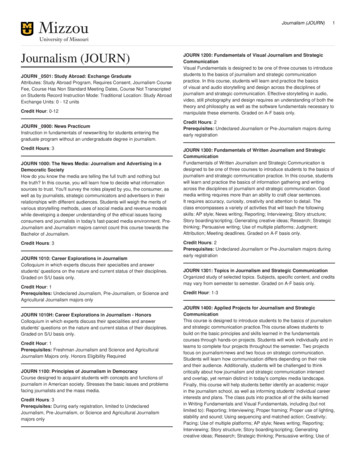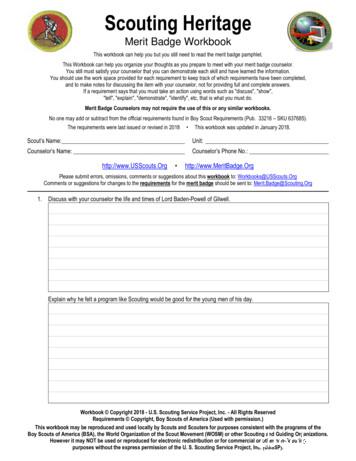Journalism - U.S. Scouting Service Project
JournalismMerit Badge WorkbookThis workbook can help you but you still need to read the merit badge pamphlet.This Workbook can help you organize your thoughts as you prepare to meet with your merit badge counselor.You still must satisfy your counselor that you can demonstrate each skill and have learned the information.You should use the work space provided for each requirement to keep track of which requirements have been completed,and to make notes for discussing the item with your counselor, not for providing full and complete answers.If a requirement says that you must take an action using words such as "discuss", "show","tell", "explain", "demonstrate", "identify", etc, that is what you must do.Merit Badge Counselors may not require the use of this or any similar workbooks.No one may add or subtract from the official requirements found in Scouts BSA Requirements (Pub. 33216 – SKU 653801).The requirements were last issued or revised in 2017 This workbook was updated in June 2020.Scout’s Name:Unit:Counselor’s Name: Phone No.: Email:http://www.USScouts.Org http://www.MeritBadge.OrgPlease submit errors, omissions, comments or suggestions about this workbook to: Workbooks@USScouts.OrgComments or suggestions for changes to the requirements for the merit badge should be sent to: Merit.Badge@Scouting.Org1. Explain what freedom of the press is and how the First Amendment guarantees that you can voice your opinion.Freedom of the pressHow the First Amendment guarantees that you can voice your opinion.Workbook Copyright 2020 - U.S. Scouting Service Project, Inc. - All Rights ReservedRequirements Copyright, Boy Scouts of America (Used with permission.)This workbook may be reproduced and used locally by Scouts and Scouters for purposes consistent with the programs of theBoy Scouts of America (BSA), the World Organization of the Scout Movement (WOSM) or other Scouting and Guiding Organizations.However it may NOT be used or reproduced for electronic redistribution or for commercial or other non-Scoutingpurposes without the express permission of the U. S. Scouting Service Project, Inc. (USSSP).
JournalismScout's Name:In your discussion, tell how to distinguish between fact and opinion, and explain the terms libel, slander, defamation, faircomment and criticism, public figure, privacy, and malice.Fact:Opinion:Libel:Slander:Defamation:Fair comment and criticism:Public figure:Privacy:Journalism - Merit Badge WorkbookPage. 2 of 12
JournalismScout's Name:Malice:Discuss how these matters relate to ethics in journalism.2. Do either A OR B:c a.Newspaper, magazine, and online journalism:1. All on the same day, read a local newspaper, a national newspaper, a newsmagazine, and (with yourparent’s permission) an online news source. From each source, clip, read and compare a story about thesame event. Tell your counselor how long each story is and how fair and accurate the stories are inpresenting different points of view. Tell how each source handled the story differently, depending on itspurpose or audience .StoryLocal newspaperHow Long?How Fair & Accurate?Difference in handling?Purpose or audience?Journalism - Merit Badge WorkbookPage. 3 of 12
JournalismScout's Name:National newspaperHow Long?How Fair & Accurate?Difference in handling?Purpose or audience?NewsmagazineHow Long?How Fair & Accurate?Difference in handling?Purpose or audience?Journalism - Merit Badge WorkbookPage. 4 of 12
JournalismScout's Name:Online news sourceHow Long?How Fair & Accurate?Difference in handling?Purpose or audience?2. Visit the office of a newspaper, magazine, or internet news site. Ask for a tour of the various divisions(editorial, business, and printing). During your tour, talk to an executive from the business side aboutmanagement’s relations with reporters, editors, and photographers and what makes a “good” newspaper,magazine, or internet news site.Management’s relations with reporters, editors, and photographersWhat makes a “good” newspaper magazine, or internet news site.Journalism - Merit Badge WorkbookPage. 5 of 12
JournalismScout's Name:c b. Radio and television journalism:1. All on the same day, watch a local and national network newscast, listen to a radio newscast, and (withyour parent’s permission) view a national broadcast news source online. List the different news items andfeatures presented, the different elements used, and the time in minutes and seconds and the online spacedevoted to each story. Compare the story lists, and discuss whether the stories are fair and accurate.Explain why the different news outlets treated the stories differently and/or presented a different point ofview.StoryLocal newscast:News items & features:Elements Used:Time given:Compare story lists:How Fair & Accurate?Difference in handling?Purpose or audience?Journalism - Merit Badge WorkbookPage. 6 of 12
JournalismScout's Name:National Network NewscastNews items & features:Elements Used:Time given:Compare story lists:How Fair & Accurate?Difference in handling?Purpose or audience?Journalism - Merit Badge WorkbookPage. 7 of 12
JournalismScout's Name:Radio NewscastNews items & features:Elements Used:Time given:Compare story lists:How Fair & Accurate?Difference in handling?Purpose or audience?Journalism - Merit Badge WorkbookPage. 8 of 12
JournalismScout's Name:Online news sourceNews items & features:Elements Used:Space given:Compare story lists:How Fair & Accurate?Difference in handling?Purpose or audience?Journalism - Merit Badge WorkbookPage. 9 of 12
JournalismScout's Name:2. Visit a radio or television station. Ask for a tour of the various departments, concentrating on those relatedto news broadcasts. During your tour, talk to the station manager or other station management executiveabout station operations, particularly how management and the news staff work together, and what makesa “good” station.How management and the news staff work together:What makes a “good” station:c If possible, go with a reporter to cover a news event.3. Discuss the differences between a hard news story and a feature story.A hard news storyA feature story.Journalism - Merit Badge WorkbookPage. 10 of 12
JournalismScout's Name:Explain what is the “five W’s and H.”WWWWWHThen do ONE of the following:c a. Choose a current or an unusual event of interest to you, and write either a hard news article OR a feature articleabout the event. Gear the article for print OR audio OR video journalism. Share your article with your counselor.c b. With your parent’s permission and counselor’s approval, interview someone in your community who is influentialbecause of his or her leadership, talent, career, or life experiences. Then present to our counselor either a written ororal report telling what you learned about this person.c c. With your parent’s permission and counselor’s approval, read an autobiography written by a journalist you want tolearn more about. Write an article that tells what you learned about this person and the contributions this personhas made to the field of journalism.c d. Attend a Scouting event and write a 200-word article (feature or hard news) about the event. Use either the invertedpyramid style or the chronological style. Review the article with our counselor, then submit it to your communitynewspaper or BSA local council or district newsletter for consideration.Journalism - Merit Badge WorkbookPage. 11 of 12
JournalismScout's Name:4. Attend a public event and do ONE of the following:Editor’s Note: Use the back of this sheet or other paper for this work. a. Write two newspaper articles about the event, one using the inverted pyramid style and one using the chronological style. b. Using a radio or television broadcasting style write a news story, a feature story and a critical review of the event. c. Take a series of photographs to help tell the story of the event in pictures. Include news photos and feature photos inyour presentation. Write a brief synopsis of the event as well as captions for your photos.5. Find out about three career opportunities in journalism.1.2.3.Pick one and find out the education, training, and experience required for this scuss this with your counselor, and explain why this profession might interest you.When working on merit badges, Scouts and Scouters should be aware of some vital information in the current edition ofthe Guide to Advancement (BSA publication 33088). Important excerpts from that publication can be downloaded meritbadges.pdf.You can download a complete copy of the Guide to Advancement from urnalism - Merit Badge WorkbookPage. 12 of 12
Journalism Scout's Name: _ _ _ _ Explain what is the five W s and H. W W W W W H Then do ONE of the following: c a. Choose a current or an unusual event of interest to you, and write either a hard news article OR a feature article about the event. Gear the article for print OR audio OR video journalism.
journalism as it relates to lifestyle journalism, as both have been shown to be, in many ways, driven by the audience. Lifestyle Journalism. In lifestyle journalism, journalistic doxa and journalistic habitus are created vis-à-vis a relationship with the audience. Furthermore, this relationship helps build social capital (Fürsich 2013).
Journalism, Pre-Journalism, or Science and Agricultural Journalism majors only JOURN 1200: Fundamentals of Visual Journalism and Strategic Communication Visual Fundamentals is designed to be one of three courses to introduce students to the basics of journalism and strategic communication practice.
Achieve Real Growth through Scouting Look at the picture of the bridge and Baden Powell from President Monson’s office. How is Scouting a bridge? Share your thoughts. Determine how you can bring about real growth for individuals and the Church through Scouting (see “A Century of Scouting in the Church,” Ensign, Oct. 2013, 11–15). 1
Scouting Heritage - Merit Badge Workbook Page. 2 of 7 Include in your discussion how Scouting was introduced in the United States, and the origins of Boy Scouting and Cub Scouting under Baden-Powell. Introduction in the United States: Origins of B
Journalism 5606W: Literary Aspects of Journalism Nancy Roberts This is a graduate-level course that studies the literary aspects of journalism as exemplified in, and influenced by, works of British and American writers, past and present. These include such writers as: Daniel Defoe, Charles Dickens, William Hazlitt, Samuel Clemens, Stephen Crane,
Enumerate Hickey’s role in the Indian journalism. 8. Do you think Hickey laid the foundation of Print journalism in India? Give your reasons. 9. “James Augustus Hickey is regarded as the father of Indian journalism “ – Discuss. 10. Compare J.A.Hickey and J.S.Buckinghum in developing Indian journalism. 11.
investigative reporting) as a distinctive news genre or news style and this article urges that it receive more attention. Keywords Contextual journalism, explanatory journalism, interpretive journalism, investigative journalism, news paradigm, politi
Practical Journalism. Most universities have their own studio, computer laboratory and reporters' facilities. The Journalism Higher Education Organization of Mongolia supported the publication in 2010 of the Mongolian language version of the unesco series on journalism education entitled Model Curricula for Journalism























